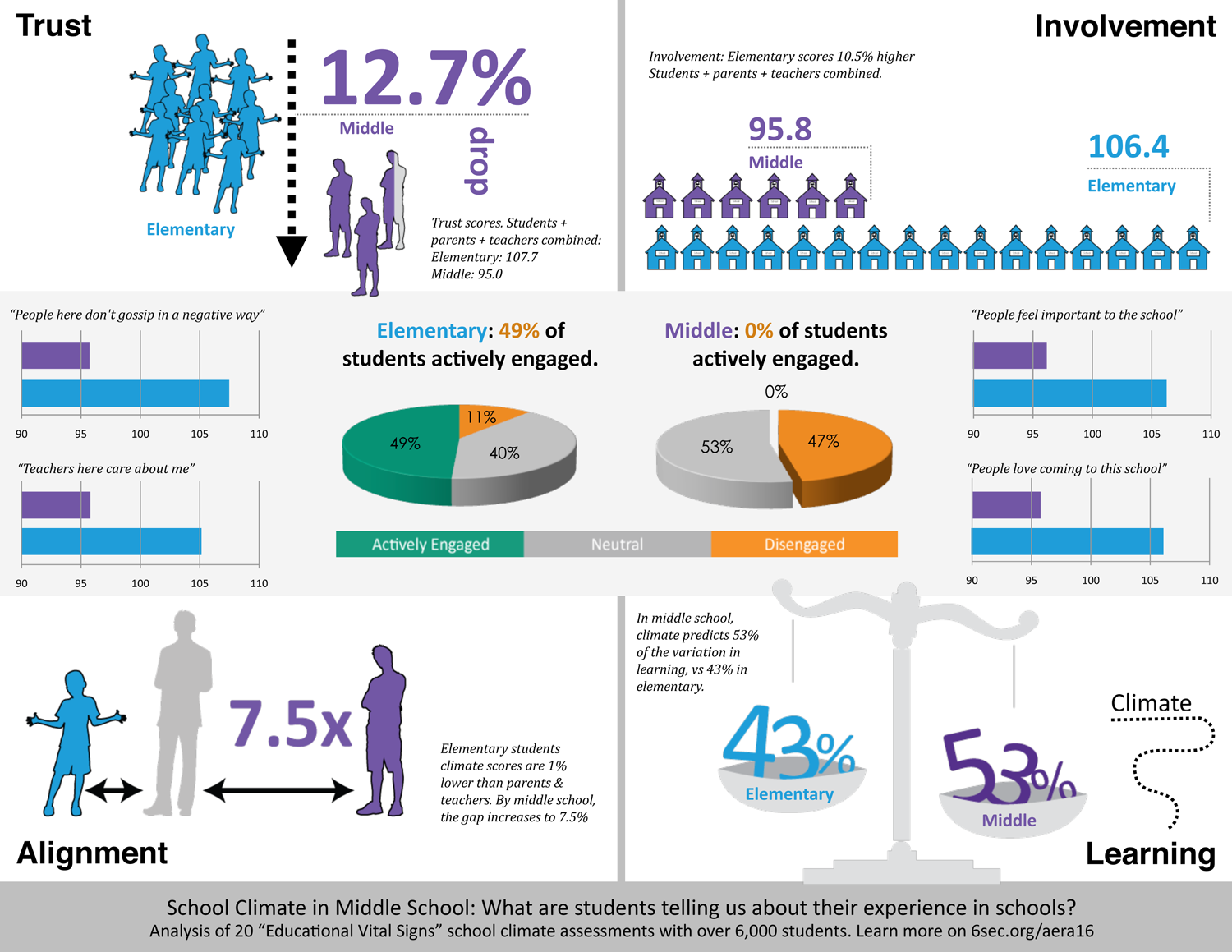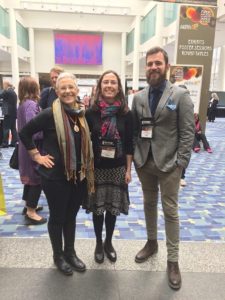What are young teens telling us about their experience in schools?
How many people remember middle school as a time of carefree fun and learning? New research sheds light on the difficult challenges of middle school. It’s a tough place for most students to learn and outcomes are impacted greatly by school climate.
Six Seconds describes school climate as an overview of all community members’ relationship with the school — what does it feel like to walk into this building or on to this campus? Climate comprises the context in which faculty work each day, in which students learn, and in which parents interact. The research shows that climate based on perceptions of “connectedness” strongly influences the outcomes of learning, safety, involvement, and thriving.
Key Factors for Young Adolescents’ School Success
The research reveals six themes pertinent to everyone working with teens:
1. School climate predicts 53% of the variation in Learning in middle school.
2. Where 49% of elementary students are actively engaged, no middle school students are in the “engaged” category. They are split between disengaged (47%) and neutral (53%)
“New research: Elementary students, 49% actively engaged. Middle school students, 0%”
Click to tweet3. A 12.7% drop in Trust occurs between elementary and middle school
4. Middle school students are stressed about ACADEMICS and SOCIAL INTERACTIONS, including finding “real” friends and positive role models
5. Middle school students see the importance of their TEACHERS AS MENTORS AND SUPPORTERS
6. Middle school students have a need to feel CARED FOR by peers and adults and feel IMPORTANT to the school
Thousands of comments on open ended questions allowed students to voice these topics in their own words. The comments generally fall into six themes: their middle school needs, their desire for teachers to be supporters and mentors, the importance of inclusion/friendship, their need for belonging, and their clear vision for education. The data is summarized in an infographic, here is part — the full graphic + report are available for free download below, including some of their comments.

We are pleased to offer you a free download of the research summary and the 2 page infographic. Just fill out the form below.
Research to Improve Education

Dr. Susan Stillman, Dr. Lorea Martinez, SEL consultant, and Tom Procicchiani from Six Seconds at the AERA 2016 conference
On April 11, 2016, the authors presented new findings about middle school learning climates at the 100th Anniversary of the AERA conference (American Educational Research Association).
Using the Six Seconds’ Educational Vital Signs (EVS) school climate survey, researchers Susan Stillman, Ilaria Boffa, and Tom Procicchiani from Six Seconds and Lorea Martinez, SEL consultant, analyzed previously collected data from over 20 schools globally, and from more than 6000 participants. The issue of school climate has garnered a good deal of attention and the session was well-attended by educational researchers seeking to understand the factors that drive student success in these challenging years.
This study was based on the premise that it is necessary to understand middle school students’ experience in schools in order to effectively design and implement SEL programs that will address the specific needs of early adolescents.
0% of Middle School Students Engaged
The school climate is a measure of the individual perception of students, parents, teachers, administrators and others involved in the school context. Data was drawn from more than 20 EVS school climate surveys of elementary, middle, and high school participants.
To calculate the Climate index in the EVS, we look at individuals, dividing them into three levels of engagement: Engaged, Neutral and Disengaged, based on the 5 drivers of climate in the EVS model.
We noticed a big drop in engagement from 49% Engaged participants in Elementary School to 0% Engaged participants in Middle School. We also can see how the Disengaged group goes from 11% in Elementary to 47% in Middle School.
The average distribution of the EVS sample is 25% Engaged, 25% Disengaged, 50% Neutral.
In the infographic, as shown above, Trust is the most important among all the five drivers. Trust dropped 12.7% between Elementary and Middle School. Fill in the form below to get the full Infographic and Research Summary.
Adults & Students Contrasting Views
Another interesting finding: Adults perceive school climate differently than students. Analyzing the scores, we saw that in Middle school the gap is 7.5 times wider than in Elementary school.
The infographic also demonstrates differences in EVS Outcomes. Involvement is the Outcome that decreases the most comparing Elementary and Middle schools, going from 106.4 to 95.8, more than 10% drop.
Finally we looked at the impact of climate on the EVS Outcomes and discovered that Learning has the strongest relationship with climate both in Elementary and Middle School, but it goes from 43% in Elementary to an even more impressive score of 53% for middle Schools.
Qualitative results indicate that middle school students express compelling needs for successful learning, including emotional safety, community and belonging, connection and relationships, and relevance. They struggle with identity concerns, achievement stress, isolation, and problem behaviors. They clearly express a vision of education that focuses around trust, supported by mentors, relationships and a sense of community, and they value an emphasis on developing the social and emotional skills needed for life.
Student Voice: What Makes School Better?
We were impressed with the profound need that students expressed for teachers who are mentors, attuned to their needs, helping them cope with stress, and modeling compassion; teachers who could help them become change-makers. Students also require the ability to make a difference in their school, through authentic involvement in planning and program development. For successful transition through middle school, students told us they require space for creativity, engagement and meaningful learning with others.
For additional discussion of this research, please see “Students’ Experiences in Middle School,” by Lorea Martinez, one of the study’s authors.
Download the Middle School Infographic and Research Summary
- Creating Connection in Higher Education - May 29, 2018
- Research: Growing an Emotionally Intelligent School - April 17, 2018
- Studying EQ in a Rural Appalachian Highschool - June 17, 2016


This has provided a new context for me. I have been aware that environment is important for some time however I have never thought of tailoring it for authentic relationships that aid learning
I do not have a comment yet as I am just getting into these resources. May have something to say later. Thanks.
I love the student comment on the infographic: “I need the support of my teachers believing in me and my friends caring about me for who I am.”
To me this captures two of the biggest challenges and opportunities in SEL for young teens.
I’ve been working in Middle School for 16 years. People often make comments about how bad our school is in comparison to the elementary or high school. We do a lot, we can always do more, around bully prevention and school connection, it is nice to see we are not alone. I always tell people it is the developmental stage they are in and we are trying. It takes a village. We need to do more on SEL, we need a better program than what we have, I am looking for ideas to make these middle school years better. Any resources you can post would be amazing. Thank you Susan!!!